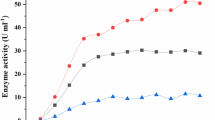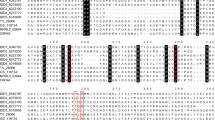Abstract
The presence of cytochrome P450 and P450-mediated phenanthrene oxidation in the white rot fungus Phanerochaete chrysosporium under ligninolytic condition was first demonstrated in this study. The carbon monoxide difference spectra indicated induction of P450 (130 pmol mg−1 in the microsomal fraction) by phenanthrene. The microsomal P450 degraded phenanthrene with a NADPH-dependent activity of 0.44 ± 0.02 min−1. One of major detectable metabolites of phenanthrene in the ligninolytic cultures and microsomal fractions was identified as phenanthrene trans-9,10-dihydrodiol. Piperonyl butoxide, a P450 inhibitor which had no effect on manganese peroxidase activity, significantly inhibited phenanthrene degradation and the trans-9,10-dihydrodiol formation in both intact cultures and microsomal fractions. Furthermore, phenanthrene was also efficiently degraded by the extracellular fraction with high manganese peroxidase activity. These results indicate important roles of both manganese peroxidase and cytochrome P450 in phenanthrene metabolism by ligninolytic P. chrysosporium.






Similar content being viewed by others
Abbreviations
- ABTS:
-
2,2′-azinobis-(3-ethylbenzthiazoline-6-sulfonate)
- HPLC:
-
High performance liquid chromatography
- LiP:
-
Lignin peroxidase
- LN:
-
Low nitrogen
- MnP:
-
Manganese-dependent peroxidase
- P420:
-
Cytochrome P420
- P450:
-
Cytochrome P450
- PAHs:
-
Polycyclic aromatic hydrocarbons
- PB:
-
Piperonyl butoxide
- PDA:
-
Potato dextrose agar
References
Aiken BS, Logan BE (1996) Degradation of pentachlorophenol by the white rot fungus Phanerochaete chrysosporium grown in ammonium lignosulphonate media. Biodegradation 7:175–182
Bao Z, Yang SK (1991) Liquid chromatographic separation of isomeric phenanthrols on monomeric and polymeric C18 columns. J Chromatogr 536:245–249
Bezalel L, Hadar Y, Fu PP, Freeman JP, Cerniglia CE (1996) Metabolism of phenanthrene by the white rot fungus Pleurotus ostreatus. Appl Environ Microbiol 62:2547–2553
Bezalel L, Hadar Y, Cerniglia CE (1997) Enzymatic mechanisms involved in phenanthrene degradation by the white rot fungus Pleurotus ostreatus. Appl Environ Microbiol 63:2495–2501
Black JA, Birge WJ, Westerman AG, Francis PC (1983) Comparative aquatic toxicology of aromatic hydrocarbons. Fundam Appl Toxicol 3:353–358
Bohmer S, Messner K, Srebotnik E (1998) Oxidation of phenanthrene by a fungal laccase in the presence of 1-hydroxybenzotriazole and unsaturated lipids. Biochem Biophys Res Commun 244:233–238
Bradford MM (1976) A rapid and sensitive method for the quantification of microgram quantities of protein utilizing the principle of protein-dye binding. Anal Biochem 72:248–254
Brodkorb TS, Legge RL (1992) Enhanced biodegradation of phenanthrene in oil tar-contaminated soils supplemented with Phanerochaete chrysosporium. Appl Environ Microbiol 58:3117–3121
Bruice PY, Bruice TC, Dansette PM, Selander HG, Yagi H, Jerina DM (1976) Comparison of the mechanisms of solvolysis and rearrangement of K-region vs. non-K-region arene oxides of phenanthrene. Comparative solvolytic rate constants of K-region and non-K-region arene oxides. J Am Chem Soc 98:2965–2973
Bumpus JA (1989) Biodegradation of polycyclic aromatic hydrocarbons by Phanerochaete chrysosporium. Appl Environ Microbiol 55:154–158
Bumpus JA, Aust SD (1987) Biodegradation of environmental pollutants by the white rot fungus Phanerochaete chrysosporium: involvement of the lignin degrading system. Bioessays 6:166–170
Bumpus JA, Tien M, Wright D, Aust SD (1985) Oxidation of persistent environmental pollutants by a white rot fungus. Science 228:1434–1436
Casillas RP, Crow SA Jr, Heinze TM, Deck J, Cerniglia CE (1996) Initial oxidative and subsequent conjugative metabolites produced during the metabolism of phenanthrene by fungi. J Ind Microbiol 16:205–215
Cerniglia CE, Heitkamp MA (1989) Microbial degradation of polycyclic aromatic hydrocarbons (PAH) in the aquatic environment. In: Varanasi U (ed) Metabolism of polycyclic aromatic hydrocarbons in the aquatic environment, 1st edn. CRC Press, Boca Raton, pp 41–68
Cerniglia CE, Yang SK (1984) Stereoselective metabolism of anthracene and phenanthrene by the fungus Cunninghamella elegans. Appl Environ Microbiol 47:119–124
Cerniglia CE, Campbell WL, Freeman JP, Evans FE (1989) Identification of a novel metabolite in phenanthrene metabolism by the fungus Cunninghamella elegans. Appl Environ Microbiol 536:2275–2279
Colores GM, Ward DM, Inskeep WP (2007) Competitive fitness of isolates enriched on phenanthrene sorbed to model phases. Appl Environ Microbiol 73:4074–4077
Daliang N, Hui W, Yuan Z, Dong L (2007) Inducement and degradation function of p450 in Phanerochaete chrysospofium by in situ spectroscopic analysis. Chem J Chin Univ-Chin 28:1469–1474
Dhawale SW, Dhawale SS, Deanross D (1992) Degradation of phenanthrene by Phanerochaete chrysosporium occurs under ligninolytic as well as nonligninolytic conditions. Appl Environ Microbiol 58:3000–3006
Doddapaneni H, Yadav JS (2004) Differential regulation and xenobiotic induction of tandem P450 monooxygenase genes pc-1 (CYP63A1) and pc-2 (CYP63A2) in the white-rot fungus Phanerochaete chrysosporium. Appl Microbiol Biotechnol 65:559–565
Doddapaneni H, Yadav JS (2005) Microarray-based global differential expression profiling of P450 monooxygenases and regulatory proteins for signal transduction pathways in the white rot fungus Phanerochaete chrysosporium. Mol Genet Genomics 274:454–466
Doddapaneni H, Subramanian V, Yadav J (2005) Physiological regulation, xenobiotic induction, and heterologous expression of p450 monooxygenase gene pc-3 (CYP63A3), a new member of the CYP63 gene cluster in the white-rot fungus Phanerochaete chrysosporium. Curr Microbiol 50:292–298
Grasselli JG, Ritchey WM (1975) CRC atlas of spectral data and physical constants for organic compounds. CRC Press, Cleveland
Hammel KE, Kalyanaraman B, Kirk TK (1986) Oxidation of polycyclic aromatic hydrocarbons and dibenzo[p]-dioxins by Phanerochaete chrysosporium ligninase. J Biol Chem 261:16948–16952
Hammel KE, Gai WZ, Green B, Moen MA (1992) Oxidative degradation of phenanthrene by the ligninolytic fungus Phanerochaete chrysosposium. Appl Environ Microbiol 58:1832–1838
Hiratsuka N, Oyadomari M, Shinohara H, Tanaka H, Wariishi H (2005) Metabolic mechanisms involved in hydroxylation reactions of diphenyl compounds by the lignin-degrading basidiomycete Phanerochaete chrysosporium. Biochem Eng J 23:241–246
Jacob J, Doehmer J, Grimmer G, Soballa V, Raab G, Seidel A, Greim H (1996) Metabolism of phenanthrene, benz[a]anthracene, benzo[a]pyrene, chrysene and benzo[c]phenanthrene by eight cDNA-expressed human and rat cytochromes P450. Polycycl Aromat Compd 10:1–9
Jerina DM, Selander H, Yagi H, Wells MC, Davey JF, Mahadevan V, Gibsonlb DT (1976) Dihydrodiols from anthracene and phenanthrene. J Am Chem Soc 98:5988–5996
Korytko PJ, Quimby FW, Scott JG (2000) Metabolism of phenanthrene by house fly CYP6D1 and dog liver cytochrome P450. J Biochem Mol Toxicol 14:20–25
Kullman SW, Matsumura F (1996) Metabolic pathways utilized by Phanerochaete chrysosporium for degradation of the cyclodiene pesticide endosulfan. Appl Environ Microbiol 62:593–600
Kusk KO (1981) Comparison of the effects of aromatic hydrocarbons on a laboratory alga and natural phytoplankton. Bot Mar 24:611–613
Luykx DMAM, Prenafeta-Boldu FX, de Bont JAM (2003) Toluene monooxygenase from the fungus Cladosporium sphaerospermum. Biochem Biophys Res Commun 312:373–379
Mallick S, Chatterjee S, Dutta TK (2007) A novel degradation pathway in the assimilation of phenanthrene by Staphylococcus sp strain PN/Y via meta-cleavage of 2-hydroxy-1-naphthoic acid: formation of trans-2,3-dioxo-5-(2′-hydroxyphenyl)pent-4-enoic acid. Microbiology-(UK) 153:2104–2115
Marston CP, Pereira C, Ferguson J, Fischer K, Hedstrom O, Dashwood W-M, Baird WM (2001) Effect of a complex environmental mixture from coal tar containing polycyclic aromatic hydrocarbons (PAH) on the tumor initiation, PAH–DNA binding and metabolic activation of carcinogenic PAH in mouse epidermis. Carcinogenesis 22:1077–1086
Martinez D, Larrondo LF, Putnam N, Gelpke MDS, Huang K, Chapman J, Helfenbein KG, Ramaiya P, Detter JC, Larimer F, Coutinho PM, Henrissat B, Berka R, Cullen D, Rokhsar D (2004) Genome sequence of the lignocellulose degrading fungus Phanerochaete chrysosporium strain RP78. Nat Biotechnol 22:695–700
Masaphy S, Levanon D, Henis Y, Venkateswarlu K, Kelly SL (1996) Evidence for cytochrome P-450 and P-450-mediated benzo(a)pyrene hydroxylation in the white rot fungus Phanerochaete chrysosporium. FEMS Microbiol Lett 135:51–55
Masaphy S, Krinfeld B, Levanon D (1998) Induction of linoleic acid-supported benzo(a)pyrene hydroxylase activity by manganese in the white rot fungus Pleurotus pulmonarius. Chemosphere 36:2933–2940
Maspahy S, Lamb DC, Kelly SL (1999) Purification and characterization of a benzo[a]pyrene hydroxylase from Pleurotus pulmonarius. Biochem Biophys Res Commun 266:326–329
Mastrangelo G, Fadda E, Marzia V (1996) Polycyclic aromatic hydrocarbons and cancer in man. Environ Health Perspect 104:1166–1170
Moen MA, Hammel KE (1994) Lipid-peroxidation by the manganese peroxidase of Phanerochaete chrysosporium is the basis for phenanthrene oxidation by the intact fungus. Appl Environ Microbiol 60:1956–1961
Moody JD, Freeman JP, Doerge DR, Cerniglia CE (2001) Degradation of phenanthrene and anthracene by cell suspensions of Mycobacterium sp. Strain PYR-1. Appl Environ Microbiol 67:1476–1483
Morgan P, Lewis ST, Watkinson RJ (1991) Comparison of abilities of white-rot fungi to mineralize selected xenobiotic compounds. Appl Microbiol Biotechnol 34:693–696
Mori T, Kitano S, Kondo R (2003) Biodegradation of chloronaphthalenes and polycyclic aromatic hydrocarbons by the white-rot fungus Phlebia lindtneri. Appl Microbiol Biotechnol 61:380–383
Mougin C, Pericaud C, Malosse C, Laugero C, Asther M (1996) Biotransformation of the insecticide lindane by the white rot basidiomycete Phanerochaete chrysosporium. Pestic Sci 47:51–59
Mougin C, Laugero C, Asther M, Chaplain V (1997) Biotransformation of s-triazine herbicides and related degradation products in liquid cultures by the white rot fungus Phanerochaete chrysosporium. Pestic Sci 49:169–177
Niku-Paavola ML, Karhunen E, Salola P, Raunio V (1988) Ligninolytic enzymes of the white-rot fungus Phlebia radiata. Biochem J 254:877–884
Nordqvist M, Thakker DR, Vyas KP, Yagi H, Levin W, Ryan DE, Thomas PE, Conney AH, Jerina DM (1981) Metabolism of chrysene and phenanthrene to bay-region dihydrodiolepoxides by rat liver enzymes. Mol Pharmacol 19:168–178
Omura T (1999) Forty years of cytochrome P450. Biochem Biophys Res Commun 266:690–698
Omura T, Sato R (1964) The carbon monoxide-binding pigment of liver microsomes. J Biol Chem 239:2370–2378
Pangrekar J, Kole PL, Honey SA, Kumar S, Sikka HC (2003) Metabolism of phenanthrene by brown bullhead liver microsomes. Aquat Toxicol 64:407–418
Paszczynski A, Crawford RL, Huynh VB (1988) Manganese peroxidase of Phanerochaete chrysosporium: Purification. Methods Enzymol 161:264–270
Pickard MA, Roman R, Tinoco R, Vazquez-Duhalt R (1999) Polycyclic aromatic hydrocarbon metabolism by white rot fungi and oxidation by Coriolopsis gallica UAMH 8260 laccase. Appl Environ Microbiol 65:3805–3809
Pipe RK, Moore MN (1986a) An ultrastructural study on the effects of phenanthrene on lysosomal membranes and distribution of the lysosomal enzyme β-glucuronidase in digestive cells of the periwinkle Littorina littorea. Aquat Toxicol 8:65–76
Pipe RK, Moore MN (1986b) Arylsulphatase activity associated with phenanthrene induced digestive cell deletion in the marine mussel Mytilus edulis. Histochem J 18:557–564
Sato R, Omura T (1978) Cytochrome P-450. Kodansha, Tokyo, Academic Press, New York
Shou M, Korzekwa KR, Gonzalez FJ, Gelboin HV (1994) Stereoselective metabolism of phenanthrene, chrysene and benzo(a)pyrene by cDNA expressed human, rodent and rabbit cytochromes P450. Proceedings of the American Association for Cancer Research Annual Meeting, 35:137
Subramanian V, Yadav JS (2008) Regulation and heterologous expression of P450 enzyme system components of the white rot fungus Phanerochaete chrysosporium. Enzyme Microb Technol 43:205–213
Sutherland JB, Freeman JP, Selby AL, Fu PP, Miller DW, Cerniglia CE (1990) Stereoselective formation of a K-region dihydrodiol from phenanthrene by Streptomyces flavovirens. Arch Microbiol 154:260–266
Sutherland JB, Selby AL, Freeman JP, Evans FE, Cerniglia CE (1991) Metabolism of phenanthrene by Phanerochaete chrysosporium. Appl Environ Microbiol 57:3310–3316
Sutherland JB, Fu PP, Yang SK, Tungeln LSV, Casillas RP, Crow SA, Cerniglia CE (1993) Enantiomeric composition of the trans-dihydrodiols produced from phenanthrene by fungi. Appl Environ Microbiol 59:2145–2149
Tatarko M, Bumpus JA (1994) Biodegradation of phenanthrene by Phanerochaete chrysosporium: on the role of lignin peroxidase. Lett Appl Microbiol 17:20–24
Teramoto H, Tanaka H, Wariishi H (2004a) Fungal cytochrome P450s catalyzing hydroxylation of substituted toluenes to form their hydroxymethyl derivatives. FEMS Microbiol Lett 234:255–260
Teramoto H, Tanaka H, Wariishi H (2004b) Degradation of 4-nitrophenol by the lignin-degrading basidiomycete Phanerochaete chrysosporium. Appl Microbiol Biotechnol 66:312–317
Tien M, Kirk TK (1988) Lignin peroxidase of Phanerochaete chrysosporium. Methods Enzymol 161:238–249
Xue W, Warshawsky D (2005) Metabolic activation of polycyclic and heterocyclic aromatic hydrocarbons and DNA damage: a review. Toxicol Appl Pharmacol 206:73–93
Yadav JS, Doddapaneni H, Subramanian V (2006) P450ome of the white rot fungus Phanerochaete chrysosporium: structure, evolution and regulation of expression of genomic P450 clusters. Biochem Soc Trans 34:1165–1169
Zheng ZM, Obbard JP (2002) Removal of surfactant solubilized polycyclic aromatic hydrocarbons by Phanerochaete chrysosporium in a rotating biological contactor reactor. J Biotechnol 96:241–249
Acknowledgement
This work was supported by National Nature Science Foundation of China (Admission No. 30400012 and 20737001) and Special Fund of State Key Joint Laboratory of Environment Simulation and Pollution Control (Nos. 08Z02ESPCT and 09Y03ESPCT).
Author information
Authors and Affiliations
Corresponding author
Rights and permissions
About this article
Cite this article
Ning, D., Wang, H., Ding, C. et al. Novel evidence of cytochrome P450-catalyzed oxidation of phenanthrene in Phanerochaete chrysosporium under ligninolytic conditions. Biodegradation 21, 889–901 (2010). https://doi.org/10.1007/s10532-010-9349-9
Received:
Accepted:
Published:
Issue Date:
DOI: https://doi.org/10.1007/s10532-010-9349-9




